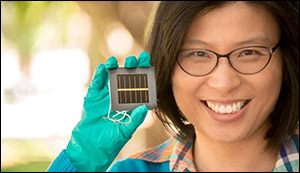Perovskite solar cells hit new world efficiency record
2. 12. 2016 | TechXplore | techxplore.com
They're flexible, cheap to produce and simple to make - which is why perovskites are the hottest new material in solar cell design. And now, engineers at Australia's University of New South Wales in Sydney have smashed the trendy new compound's world efficiency record.
The 12.1% efficiency rating was for a 16 cm2 perovskite solar cell, the largest single perovskite photovoltaic cell certified with the highest energy conversion efficiency, and was independently confirmed by the international testing centre Newport Corp, in Bozeman, Montana. The new cell is at least 10 times bigger than the current certified high-efficiency perovskite solar cells on record.

Australian team has also achieved an 18% efficiency rating on a 1.2 cm2 single perovskite cell, and an 11.5% for a 16 cm2 four-cell perovskite mini-module, both independently certified by Newport.
Perovskite is a structured compound, where a hybrid organic-inorganic lead or tin halide-based material acts as the light-harvesting active layer. They are the fastest-advancing solar technology to date, and are attractive because the compound is cheap to produce and simple to manufacture, and can even be sprayed onto surfaces.
Read more at TechXplore
Image Credit: Rob Largent/UNSW
-jk-




